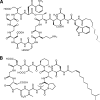Daptomycin versus Friulimicin B: in-depth profiling of Bacillus subtilis cell envelope stress responses
- PMID: 19164157
- PMCID: PMC2663105
- DOI: 10.1128/AAC.01046-08
Daptomycin versus Friulimicin B: in-depth profiling of Bacillus subtilis cell envelope stress responses
Abstract
The related lipo(depsi)peptide antibiotics daptomycin and friulimicin B show great potential in the treatment of multiply resistant gram-positive pathogens. Applying genome-wide in-depth expression profiling, we compared the respective stress responses of Bacillus subtilis. Both antibiotics target envelope integrity, based on the strong induction of extracytoplasmic function sigma factor-dependent gene expression. The cell envelope stress-sensing two-component system LiaRS is exclusively and strongly induced by daptomycin, indicative of different mechanisms of action in the two compounds.
Figures



References
-
- Aretz, W., J. Meiwes, G. Seibert, G. Vobis, and J. Wink. 2000. Friulimicins: novel lipopeptide antibiotics with peptidoglycan synthesis inhibiting activity from Actinoplanes friuliensis sp. nov. I. Taxonomic studies of the producing microorganism and fermentation. J. Antibiot. (Tokyo) 53:807-815. - PubMed
-
- Baltz, R. H., V. Miao, and S. K. Wrigley. 2005. Natural products to drugs: daptomycin and related lipopeptide antibiotics. Nat. Prod. Rep. 22:717-741. - PubMed
-
- Brazas, M. D., and R. E. Hancock. 2005. Using microarray gene signatures to elucidate mechanisms of antibiotic action and resistance. Drug Discov. Today 10:1245-1252. - PubMed
Publication types
MeSH terms
Substances
LinkOut - more resources
Full Text Sources
Medical

